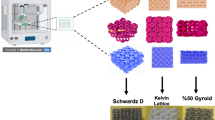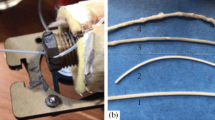Abstract
Toughness is a prerequisite for bone scaffold matrix material if such material is to be used in clinic. Blending with polycaprolactone (PCL) is the most used method to improve the toughness of polylactic acid (PLA), while improving their miscibility in the absence of the compatibilizer is always a challenge. To address this issue, the printing process was proposed to improve the miscibility of PLA and PCL. PLA/PCL Blends at different compositions were extruded into filaments and used to print samples. The results of Fourier transform infrared and thermogravimetric analysis indicate that the processing temperatures of the extruder and FDM printer do not cause the degradation of PCL in blend. Following, the influence of FDM printing process on their miscibility was investigated in terms of mechanical properties, surface morphology and melting behavior. Results show that the printing process can effectively improve the miscibility and toughness, and the most appropriate PCL concentration used to blend with PLA is 20 wt.%. At 20 wt.% PCL concentration, the printed blend has an elongation of 189%, which is an increase of about 950% compared with pure PLA. This research not only expands the PLA/PCL blend research, but also provides a process guidance for FDM printing PLA/PCL bone scaffolds.







Similar content being viewed by others
References
K. Jelonek, S. Li, B. Kaczmarczyk, A. Marcinkowski, A. Orchel, M. Musial-Kulik and J. Kasperczyk, Multidrug PLA-PEG Filomicelles for Concurrent Delivery of Anticancer Drugs-The Influence of Drug-Drug and Drug-Polymer Interactions on Drug Loading and Release Properties, Int. J. Pharm., 2016, 510, p 365–374. https://doi.org/10.1016/j.ijpharm.2016.06.051
M. Harris, J. Potgieter, R. Archer and K.M. Arif, In-process Thermal Treatment of Polylactic Acid in Fused Deposition Modeling, Mater. Manuf. Process., 2019, 34, p 701–713. https://doi.org/10.1080/10426914.2019.1566611
S. Liu, J. Yu, H. Li, K. Wang, G. Wu, B. Wang, M. Liu, Y. Zhang, P. Wang, J. Zhang et al., Controllable Drug Release Behavior of Polylactic Acid (PLA) Surgical Suture Coating with Ciprofloxacin (CPFX)-Polycaprolactone (PCL)/Polyglycolide (PGA), Polymers, 2020, 12, p 288. https://doi.org/10.3390/polym12020288
D. Silva, M. Kaduri, M. Poley, O. Adir, N. Krinsky, J. Shainsky-Roitman and A. Schroeder, Biocompatibility, Biodegradation and Excretion of Polylactic Acid (PLA) in Medical Implants and Theranostic Systems, Chem. Eng. J., 2018, 340, p 9–14. https://doi.org/10.1016/j.cej.2018.01.010
Q. Wei, X. Cai, Y. Guo, G. Wang, Y. Guo, M. Lei, Y. Song, Y. Zhang and Y. Wang, Atomic-Scale and Experimental Investigation on the Micro-Structures and Mechanical Properties of PLA Blending with CMC for Additive Manufacturing, Mater. Des., 2019, 183, 108158. https://doi.org/10.1016/j.matdes.2019.108158
Q. Wei, G. Wang, M. Lei, Y. Guo, Y. Song, T. Lu and Y. Wang, Multi-Scale Investigation on the Phase Miscibility of Polylactic Acid/O-Carboxymethyl Chitosan Blends, Polymer, 2019, 176, p 159–167. https://doi.org/10.1016/j.polymer.2019.05.030
H. Saniei and S. Mousavi, Surface Modification of PLA 3D-Printed Implants by Electrospinning with Enhanced Bioactivity and Cell Affinity, Polymer, 2020, 196, 122467. https://doi.org/10.1016/j.polymer.2020.122467
D. Wu, A. Spanou, A. Diez-Escudero and C. Persson, 3D-Printed PLA/HA Composite Structures as Synthetic Trabecular Bone: A Feasibility Study Using Fused Deposition Modeling, J. Mech. Behav. Biomed. Mater., 2020, 103, 103608. https://doi.org/10.1016/j.jmbbm.2019.103608
F. Li, Z. Yu and Z. Yang, Failure Characterization of PLA Parts Fabricated by Fused Deposition Modeling Using Acoustic Emission, Rapid Prototyp. J., 2020, 26, p 1177–1182. https://doi.org/10.1108/RPJ-09-2019-0247
M. Neufurth, X. Wang, S. Wang, R. Steffen, M. Ackermann, N.D. Haep, H.C. Schroder and W.E.G. Muller, 3D Printing of Hybrid Biomaterials for Bone Tissue Engineering: Calcium-Polyphosphate Microparticles Encapsulated by Polycaprolactone, Acta Biomater., 2017, 64, p 377–388. https://doi.org/10.1016/j.actbio.2017.09.031
K.S. Stankevich, V.L. Kudryavtseva, E.N. Bolbasov, E.V. Shesterikov, I.V. Larionova, Y.G. Shapovalova, L.V. Domracheva, A.A. Volokhova, I.A. Kurzina, Y.M. Zhukov et al., Modification of PCL Scaffolds by Reactive Magnetron Sputtering: a Possibility for Modulating Macrophage Responses, ACS Biomater. Sci. Eng., 2020, 6, p 3967–3974. https://doi.org/10.1021/acsbiomaterials.0c00440
S. Park, J. Kim, M.K. Lee, C. Park, H.D. Jung, H.E. Kim and T.S. Jang, Fabrication of Strong, Bioactive Vascular Grafts with PCL/collagen and PCL/Silica Bilayers for Small-Diameter Vascular Applications, Mater. Des., 2019, 181, 108079. https://doi.org/10.1016/j.matdes.2019.108079
N.K. Kalita, S.M. Bhasney, C. Mudenur, A. Kalamdhad and V. Katiyar, End-of-Life Evaluation and Biodegradation of Poly(Lactic Acid) (PLA)/Polycaprolactone (PCL)/MICROCRYSTALLINE Cellulose (MCC) Polyblends Under Composting Conditions, Chemosphere, 2020, 247, 125875. https://doi.org/10.1016/j.chemosphere.2020.125875
P.D. Dias and M.A. Chinelatto, Effect of Poly(Epsilon-Caprolactone-b-Tetrahydrofuran) Triblock Copolymer Concentration on Morphological, Thermal and Mechanical Properties of Immiscible PLA/PCL Blends, J. Renew. Mater., 2019, 7, p 129–138. https://doi.org/10.32604/jrm.2019.00037
A. Ostafinska, I. Fortelny, J. Hodan, S. Krejcikova, M. Nevoralova, J. Kredatusova, Z. Krulis, J. Kotek and M. Slouf, Strong Synergistic Effects in PLA/PCL Blends: Impact of PIA Matrix Viscosity, J. Mech. Behav. Biomed. Mater., 2017, 69, p 229–241. https://doi.org/10.1016/j.jmbbm.2017.01.015
Z. Tadmor and C.G. Gogos, Principles of Polymer Processing, Wiley , Hoboken, 2006.
Q. Wei, Y. Zhang, Y. Wang and X. Chen, Aggregation Behavior of Nano-Silica in Polyvinyl Alcohol/Polyacrylamide Hydrogels Based on Dissipative Particle Dynamics, Polymers, 2017, 9(11), p 611. https://doi.org/10.3390/polym9110611
X.L. Wang and A.P. Chatterjee, Shear-Induced Effects on Miscibility in Polymer Solutions, Mol. Phys., 2002, 100, p 2587–2595. https://doi.org/10.1080/00268970210131370
J. Wu, N. Chen, F. Bai and Q. Wang, Preparation of Poly(Vinyl Alcohol)/Poly(Lactic Acid)/Hydroxyapatite Bioactive Nanocomposites for Fused Deposition Modeling, Polym. Compos., 2018, 39, p 508–518. https://doi.org/10.1002/pc.24642
J. Zhang, Y. Duan, H. Sato, H. Tsuji, I. Noda, S. Yan and Y. Ozaki, Crystal Modifications and Thermal Behavior of Poly(l-Lactic Acid) Revealed by Infrared spectroscopy, Macromolecules, 2005, 38, p 8012–8021. https://doi.org/10.1021/ma051232r
L. de Siqueira, N. Ribeiro, M.B.A. Paredes, L. Grenho, C. Cunha-Reis, E.S. Triches, M.H. Fernandes, S.R. Sousa and F.J. Monteiro, Influence of PLLA/PCL/HA Scaffold Fiber Orientation on Mechanical Properties and Osteoblast Behavior, Materials., 2019, 12, p 3879. https://doi.org/10.3390/ma12233879
K. del Ángel-Sánchez, C. Borbolla-Torres, L.M. Palacios-Pineda, N.A. Ulloa-Castillo and A. Elias-Zuniga, Development, Fabrication, and Characterization of Composite Polycaprolactone Membranes Reinforced with TiO2 Nanoparticles, Polymers, 1955, 2019, p 11. https://doi.org/10.3390/polym11121955
H.T. Sasmaze, Novel Hybrid Scaffolds for the Cultivation of Osteoblast Cells, Macromolecules, 2011, 49, p 838–846. https://doi.org/10.1016/j.ijbiomac.2011.07.022
B.T. Duymaz, F.B. Erdiler, T. Alan, M.O. Aydogdu, A.T. Inan, N. Ekren, M. Uzun, Y.M. Sahin, E. Bulus and F.N. Oktar, 3D Bio-printing of Levan/Polycaprolactone/Gelatin Blends for Bone Tissue Engineering: Characterization of the Cellular Behavior, Eur. Polymer J., 2019, 119, p 426–437. https://doi.org/10.1016/j.eurpolymj.2019.08.015
H.Y. Ren, Z.L. He, D.L. Li, L. Zhang, L.N. Chen, Y.W. Lou and M.D. Xu, Synergistic Enhanced Yield Strength, Tensile Ductility and Impact Toughness of Polydicyclopentadiene Nanocomposites by Introducing Low Loadings of Di-Functionalized Silica, Polym. Testing, 2019, 79, 106052. https://doi.org/10.1016/j.polymertesting.2019.106052
H.B. Song, A. Baranek, B.T. Worrell, W.D. Cook and C.N. Bowman, Photopolymerized Triazole-Based Glassy Polymer Networks with Superior Tensile Toughness, Adv. Func. Mater., 2018, 28, p 1801095. https://doi.org/10.1002/adfm.201801095
C. Samuel, J.M. Raquez and P. Dubois, PLLA/PMMA Blends: A Shear-Induced Miscibility with Tunable Morphologies and Properties?, Polymer, 2013, 54, p 3931–3939. https://doi.org/10.1016/j.polymer.2013.05.021
J. Gai, H. Li, C. Schrauwen and Hu. Guohua, Dissipative Particle Dynamics Study on the Phase Morphologies of the Ultrahigh molecular Weight Polyethylene/Polypropylene/Poly(Ethylene Glycol) Blends, Polymer, 2009, 50, p 336–346. https://doi.org/10.1016/j.polymer.2008.10.020
X. Song, P. Shi, S. Zhao, M. Duan, C. Wang and Y. Ma, Dissipative Particle Dynamics Study on the Aggregation Behavior of Asphaltenes Under Shear Fields, Ind. Eng. Chem. Res., 2016, 55, p 9077–9086. https://doi.org/10.1021/acs.iecr.6b02400
C. Song, Y. Luo, Y. Liu, S. Li, Z. Xi, L. Zhao, L. Cen and E. Lu, Fabrication of PCL Scaffolds by Supercritical CO2 Foaming Based on the Combined Effects of Rheological and Crystallization Properties, Polymers, 2020, 12, p 780. https://doi.org/10.3390/polym12040780
M.A. Cuiffo, J. Snyder, A.M. Elliott, N. Romero, S. Kannan and G.P. Halada, Impact of the Used Deposition (FDM) Printing Process on Polylactic Acid (PLA) Chemistry and Structure, Appl. Sci.-Basel., 2017, 7, p 579. https://doi.org/10.3390/app7060579
Acknowledgments
This project was sponsored by the National Natural Science Foundation of China (Grant No. 51905438), The National Key Research and Development Program of China (Grant No. 2019QY(Y)0502), the Fundamental Research Funds for the Central Universities (Grant No. 31020210506006), the Innovation Platform of Biofabrication (Grant No.17SF0002), and the Key Research and Development program of Shaanxi Province (Grant No. 2018ZDXM-GY-133). We would like to thank the Analytical & Testing Center of Northwestern Polytechnical University for SEM and FTIR tests.
Author information
Authors and Affiliations
Corresponding authors
Ethics declarations
Conflict of interest
The authors declare that they have no known competing financial interests or personal relationships that could have appeared to influence the work reported in this paper.
Additional information
Publisher's Note
Springer Nature remains neutral with regard to jurisdictional claims in published maps and institutional affiliations.
Rights and permissions
About this article
Cite this article
Wei, Q., Sun, D., Yang, R. et al. Influence of Fused Deposition Molding Printing Process on the Toughness and Miscibility of Polylactic Acid/Polycaprolactone Blends. J. of Materi Eng and Perform 31, 1338–1345 (2022). https://doi.org/10.1007/s11665-021-06293-z
Received:
Revised:
Accepted:
Published:
Issue Date:
DOI: https://doi.org/10.1007/s11665-021-06293-z




